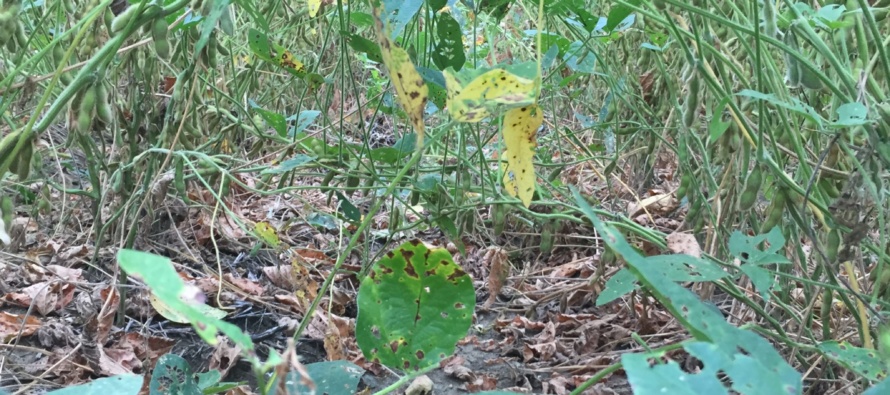Managing Target Spot of Soybean: 2016 Fungicide Trial Efficacy Results

Related Articles
- 2010 Soybean And Corn Variety Trial Data 3
- Rice Variety Trial Results For 2010, Plus Rice Research Report 0
- Evaluation of Peanut Prescription Rx Program in Mississippi 0
Latest Tweets

Severe defoliation as a result of target spot in a fungicide treated plot during 2016 in Starkville, MS.
During 2016, two separate fungicide efficacy trials were conducted in Starkville, MS. Trials were conducted with a frogeye leaf spot susceptible variety (Armor DK 4744) to look at fungicide efficacy on frogeye leaf spot as well as observed differences in phytotoxicity caused by the selected fungicides with a graduate student. Trials were sprayed with several different foliar fungicides at 15 gal/A by ground and spray applications included an adjuvant (0.25% v/v NIS). Plots were sprayed at R4 and disease was rated pre- and 2, 4, and 6 weeks post-application. Even though frogeye leaf spot was the targeted disease, severe Septoria brown spot as well as target spot were observed throughout the treated plots. Diseases were rated using a general 0 to 9 scale. However, rating for Septoria brown spot as well as target spot requires altering the scale to consider the disease within the crop canopy (from bottom to top). To rate for Septoria brown spot and target spot, rather than using the scale to consider the presence of each disease in the top of the crop canopy, the canopy was split into thirds and rated using a modified 0 to 9 scale.
0 – 3 Lower canopy
4 – 6 Middle canopy
7 – 9 Upper canopy

Target spot observations over time from two fungicide efficacy trials conducted in Starkville, MS during 2016.
Even though yield was harvested from each plot, yield data were confounded by multiple diseases and the resulting severe defoliation as a result of target spot. Based on these 2016 trials several key statements can be made. Firstly, regardless of fungicide active ingredient, target spot severity increased over time. Fungicide products applied either contained a stand-alone strobilurin (QoI), triazole (DMI), or were applied as a commercially available pre-mix (QoI + DMI) and in one case a three-way pre-mix fungicide (QoI + DMI + MBC (thiophanate-methyl)). Based on the occurrence of target spot at the three ratings post-application, fungicide products did not reduce the severity of target spot within the crop canopy. As a result of the 2016 target spot infestation, severe defoliation was observed between 4 and 6 weeks post-treatment regardless of fungicide product. Secondly, some fungicide products substantially reduced defoliation as a result of target spot; however, this did not translate into increased yield. Thirdly, the greatest difference between the two trials had to do with canopy closure within the plot area. Trial 2 did not have near as much canopy closure, but target spot was still more severe than normal as a result of the prevailing environment that occurred during 2016. Fourthly, even though not presented in this particular blog post, the response of Septoria brown spot following a fungicide application was quite similar to target spot regardless of fungicide product.
Things to keep in mind for managing soybean target spot during 2017:
- In general, soybean target spot is a disease that commonly occurs in the lower canopy.
- Environment is the most important aspect as to whether or not target spot will occur to the same degree in 2017.
- Even though environment is the main ingredient for disease to occur, some soybean varieties are extremely susceptible to target spot (more in a future post).
- Spraying a fungicide automatically and not observing target spot after the application does not mean that the fungicide “controlled” the disease.
- Keep in mind that a mixed mode of action fungicide application may be more beneficial in the MS soybean production system for 2017 and the future.
- Soybean foliar diseases occur as a complex and rarely is only one disease the target of a fungicide application.
For more on target spot see: https://www.mississippi-crops.com/2017/03/21/target-spot-management-thoughts-from-2016-observations/
For more specific information regarding the two fungicide trials conducted in Starkville during 2016:
Fungicide efficacy trial 1: 2016 Starkville trial 1
Fungicide efficacy trial 2: 2016 Starkville trial 2




Hi Tom, I´m Juan Edwards from Brazil. Here the most efficient fungicides are mixture of SDHI + Qol (fluxapyroxad + pyraclostrobin). Also the inclusion of epoxiconazole aided for yield increase. For spraying Timming you may consider start at R3. Regards!